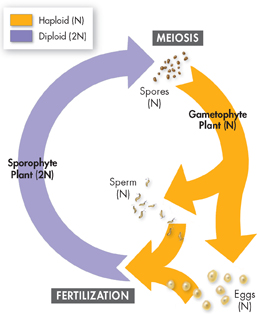The appearance of plants on land changed the rest of life on Earth. As these new organisms colonized the land, they changed the environment in ways that enabled new species to evolve. New ecosystems emerged, and organic matter began to form soil.
Several groups of plants evolved from the first pioneering land plants. One group developed into mosses. Another lineage gave rise to ferns, cone-bearing plants, and flowering plants. All of these groups of plants are now successful in living on land, but they have evolved very different adaptations for a wide range of terrestrial environments.
An Overview of the Plant Kingdom Botanists divide the plant kingdom into five major groups based on four important features: embryo formation, specialized water-conducting tissues, seeds, and flowers. The relationship of these groups to one another is shown in Figure 22–4. Plants that form embryos are often referred to as “land plants,” even though some of them now live in watery environments. Plant scientists classify plants into finer groups within these major branches by comparing the DNA sequences of various species.
 In Your Notebook Determine the key feature that a fern has in common with a flowering plant using information in Figure 22–4.
In Your Notebook Determine the key feature that a fern has in common with a flowering plant using information in Figure 22–4.
MYSTERY CLUE

Scientists extracted high levels of chlorophyll from the maple leaves found with Iceman. How could this evidence be used to determine the season of his death?
The Plant Life Cycle
 What feature defines most plant life cycles?
What feature defines most plant life cycles?
Land plants have a distinctive sexual life cycle that sets them apart from most other living organisms.  The life cycle of land plants has two alternating phases, a diploid (2N) phase and a haploid (N) phase. This shift between haploid and diploid is known as the alternation of generations.
The life cycle of land plants has two alternating phases, a diploid (2N) phase and a haploid (N) phase. This shift between haploid and diploid is known as the alternation of generations.
The multicellular diploid (2N) phase is known as the sporophyte (SPOH ruh fyt), or spore-producing plant. The multicellular haploid (N) phase is known as the gametophyte (guh MEET uh fyt), or gamete-producing plant. Recall from Chapter 11 that haploid (N) organisms carry a single set of chromosomes in their cell nuclei, while diploid (2N) organisms have two sets of chromosomes.
You can follow the basic steps of the life cycle in Figure 22–5, starting from the top. A sporophyte produces haploid spores through meiosis. These spores grow into multicellular structures called gametophytes. Each gametophyte produces reproductive cells called gametes—sperm and egg cells. During fertilization, a sperm and egg fuse with each other, producing a diploid zygote. The zygote develops into a new sporophyte, and the cycle begins again.

FIGURE 22–5 The Plant Life Cycle Most plants have a life cycle with alternation of generations, in which the haploid gametophyte phase alternates with the diploid sporophyte phase.
dTable of Contents
- Formulas and Equations
- Applying Formulas and Equations
- Mean, Median, and Mode
- Estimation
- Using Measurements in Calculations
- Effects of Measurement Errors
- Accuracy
- Precision
- Comparing Accuracy and Precision
- Significant Figures
- Calculating With Significant Figures
- Scientific Notation
- Calculating With Scientific Notation
- Dimensional Analysis
- Applying Dimensional Analysis




